英语毕业论文-广告英语中双关语的语用功能及其翻译
- 格式:doc
- 大小:101.00 KB
- 文档页数:23
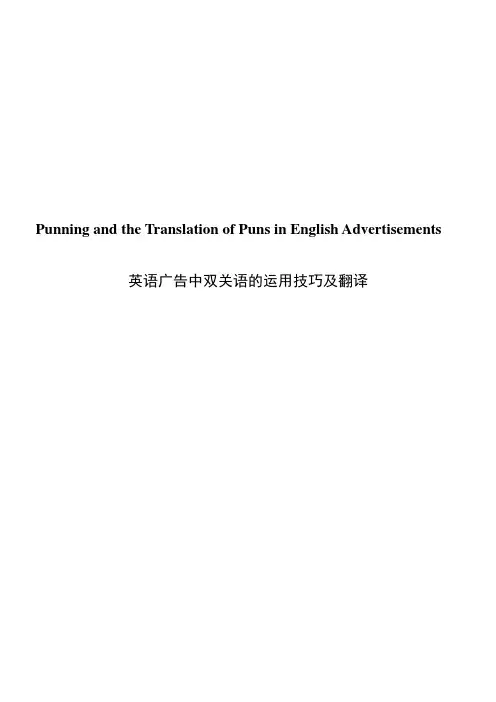
Punning and the Translation of Puns in English Advertisements 英语广告中双关语的运用技巧及翻译摘要双关语是英语广告中一种较为常见的修辞手段。
英语广告中的双关语形式多种多样。
双关语的翻译本身就是一个难点;而广告中双关语的翻译则更加复杂,因为除了语意双关之外,还需要考虑到广告本身的风格特点。
本文探讨了一些英语广告中双关语的运用技巧及翻译,从语音双关、语义双关、语法双关和成语、俗语双关等几方面对双关语的运用技巧作了阐述。
并在考虑双关语的双重含义及广告语体风格的基础上,从契合译法、灵活表义法、加注法、直译法和补偿译法等方面对英语广告双关语的翻译作了初步的探讨。
AbstractPunning is one of the most common rhetorical devices used in advertisement. There are various ways to form puns in advertisements. The translation of puns is difficult because of the double meanings, and the translation of puns in advertisements is even more difficult because one must keep both the double meanings of a pun and the style of the advertisement in mind. This paper is about the techniques of punning and the translation of puns in English advertisements. It expresses the technique of pun by the ways of homophonic pun, homographic pun, grammatical pun and idiom pun. And this paper has some preliminary discussions in punning of English advertisement through the methods of conjunct translation, nimble translation, replenishment translation, transliteration, compensate translations.[Key Words] advertising language; pun; translationContents1. Introduction (5)2. The Puns in English Advertisements (5)2.1 Homophonic Pun (5)2.1.1 Close Sound Pun (5)2.1.2 The Same Sound Pun (6)2.2 Homographic Pun (7)2.3 Grammatical Pun (9)2.3.1 Puns Created by Different Collocations (9)2.3.2 Puns Created by Different Understandings of the Same Words (9)2.4 Idiomatic Pun (10)3. Translations of Puns in English Advertisements (11)3.1 The conjunct translation (11)3.2Nimble Translation (12)3.3Replenishment Translation (13)3.4Transliteration (14)3.5Compensative Translations (16)4. Conclusion (17)1. IntroductionWhat is advertising? Advertising is the non-personal communication of information usually paid for and usually persuasive in nature about products, services or idea by identified sponsors through the various media. [1]p4 Whether it is goods advertisement or public service advertisement, the creation of the advertisement is a comprehensive art. The creation of the advertisement involves sociology, aesthetics, psychology, sound of electricity, literature and linguistics etc. The skills needed in this art are more than other forms of writing. It shows the vivid and interesting characters by the principle of salesmanship. And it has special communication to bring the reader''s attention in a moment, stimulates the desire of buying and facilitates the behavior of buying finally. Therefore, the using of precision and appropriate in advertising literary language will make the influence of advertising language far beyond the advertisement itself. The rhetorical of pun is a common skill, in creating advertisement. The pun, in Italian, “puntiglio” means “a fine point,” hence a verbal quibble, and is most likely the source of the English punctilious. A pun is defined by Webster as “the humorous use of a word, or of words which are formed or sounded alike but have different meanings, in such a way as to play on two or more of the possible application; a play on words.”[2] As the game of words, pun will leave a deep impression on readers by its readability, wit, and humor. Therefore it is used in the advertisement with a large amount.2. The Puns in English AdvertisementsThere are many kinds of puns exist in English advertisements. In this paper, four mainly types of them are talked. There are homophonic puns, homographic pun, grammatical pun and idiom pun.2.1 Homophonic PunHomophonic means two or more words are of the similar or same sound.Because “There exist no information channels of bilingual conversion at the sound level” [3] the partial sound puns are always seen in the daily life. It concludes close sound pun and the same sound pun.2.1.1 Close Sound PunClose pun means pairs or more of words having the same sound but different meanings.(1) AN ideal marriage is one in which the wife is a treasure and the husband treasury.理想的婚姻—太太是宝贝,而先生是金库.(2) Nowadays, a pair of dice is made a paradise如今,一副股子就可以成为乐园In the two examples above, both the two advertisements successfully convey the satirical tones of the two English sentences. Nevertheless, neither“宝贝,金库”nor“股子,乐园”reflect the partial tones of “treasure, treasury”and “pair of dice, paradise”. It just put one layer of the double meaning into Chinese and the pun affect disappears without any trail.(3) Centrum with beta-caroteneFrom A to ZincMore Complete [4] P15富含胡萝卜的珍多美,从A到锌,应有尽有,营养更全,口味更新!This is one of food advertis ement named centum. “From A to Zinc” harmonics with the English phrase “From A to the Z”, the latter meaning refers “comprehensively, complete”. The pun here wants to explain this kind of food nutrition rich in prominent, all contains from Vitamin A (namely carrot element) to the zinc element, has the extreme power of persuasion..2.1.2 The Same Sound PunThe same sound pun means the words have the same sound but have different meanings.(4)Have a nice trip, buy-buy![5]祝君旅途愉快,拜拜/快买!“Buy-buy” is a varied spelling, and it unison with “bye-bye”. Airport store says goodbye to the passenger, the purpose is that reminds everybody to buy a present or other thing to bring with just before leaving. “Buy-Buy”! Forms in one''s mind ingeniously, humorous to be humor ous, makes one thump the table and shout praise.(5)Forget hot tasteOnly Kool, with pure menthol has the taste of extra coolnessCome up to Kool.[6]P49忘掉辛辣的感觉,只有“酷”牌,纯正的薄荷口味给你特别清凉的酷酷感觉,想酷你就来!This is one of the cigarette advertisements, in sentence “kool” is a unison pun, it both refer to cigarette and the cool feeling. In order to prominent product out of the ordinary cool characteristic, the advertisement maker fabricats word “kool” to take the cigarette’s name, using the “cool” unison, and the “hot” in first sentence also further strengthened this “cool” meaning, contrasts the Kool sign cigarette by the consumers to the “cool” feeling in the mouth.(6) Foyled again? Try Dillon.[7]又失望了?那就来Dillon书店看看吧。
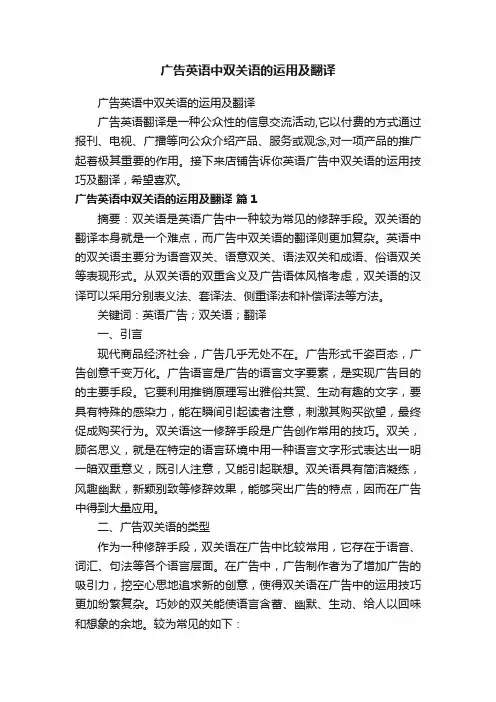
广告英语中双关语的运用及翻译广告英语中双关语的运用及翻译广告英语翻译是一种公众性的信息交流活动,它以付费的方式通过报刊、电视、广播等向公众介绍产品、服务或观念,对一项产品的推广起着极其重要的作用。
接下来店铺告诉你英语广告中双关语的运用技巧及翻译,希望喜欢。
广告英语中双关语的运用及翻译篇1摘要:双关语是英语广告中一种较为常见的修辞手段。
双关语的翻译本身就是一个难点,而广告中双关语的翻译则更加复杂。
英语中的双关语主要分为语音双关、语意双关、语法双关和成语、俗语双关等表现形式。
从双关语的双重含义及广告语体风格考虑,双关语的汉译可以采用分别表义法、套译法、侧重译法和补偿译法等方法。
关键词:英语广告;双关语;翻译一、引言现代商品经济社会,广告几乎无处不在。
广告形式千姿百态,广告创意千变万化。
广告语言是广告的语言文字要素,是实现广告目的的主要手段。
它要利用推销原理写出雅俗共赏、生动有趣的文字,要具有特殊的感染力,能在瞬间引起读者注意,刺激其购买欲望,最终促成购买行为。
双关语这一修辞手段是广告创作常用的技巧。
双关,顾名思义,就是在特定的语言环境中用一种语言文字形式表达出一明一暗双重意义,既引人注意,又能引起联想。
双关语具有简洁凝练,风趣幽默,新颖别致等修辞效果,能够突出广告的特点,因而在广告中得到大量应用。
二、广告双关语的类型作为一种修辞手段,双关语在广告中比较常用,它存在于语音、词汇、句法等各个语言层面。
在广告中,广告制作者为了增加广告的吸引力,挖空心思地追求新的创意,使得双关语在广告中的运用技巧更加纷繁复杂。
巧妙的双关能使语言含蓄、幽默、生动、给人以回味和想象的余地。
较为常见的如下:1.谐音双关谐音双关是用拼写相似,发音相同或相近的词构成的。
广告制作者非常乐于使用谐音双关,因为此类双关具有风趣、幽默、俏皮、滑稽的语言风格,能增强广告的说服力和感染力,从而给消费者留下深刻的印象。
(1)GoodbuyWinter!100%Cotton Knitwear $40这是一则冬季服装削价出售的广告。


论析英文广告中的双关语现象及其翻译策略语义双关是指利用一词多义在特定环境下而形成的双关,怎样浅析英文广告中的双关语现象及其翻译策略?一、双关语现象在英文广告中的运用及主要类型广告在我们的社会生活中占着重要的地位,它有着树立企业形象、促进营销增加交易等重要功能,广告语言也常以简短有力、简洁易懂为句法特点,然而优秀的广告离不开出色的修辞运用,为了达到提高销量的目的,广告商们必须在广告语言上下工夫,能够出色的运用双关这一特殊的修辞格,无疑能为广告添光加彩,下面就是三种不同的类型:(一)语音双关语音双关又称“谐音双关”。
语音双关是指借助发音相同或相近的词而构成的双关形式。
这类双关具有幽默风趣、滑稽俏皮的语言特点,可增强广告的感染力和说服力。
例如:Goodbuy Winter! 100%Cotton Knitwear $40.这是一则冬季服装减价销售的广告,广告设计者利用goodbye与goodbuy的谐音双关,不仅暗示消费者这是一桩不错的买卖,似乎又告诉消费者寒冷的冬日即将过去,温暖的春天正在向你招手,这难道不是在提示消费者不要错过了最佳的购买时机吗?其中的语音双关正可谓一箭双雕。
(二)语义双关语义双关是指利用一词多义在特定环境下而形成的双关,这种双关现象在字面上只有一个词语,而实际上却同时关顾着两种不同的意思,在广告中对该词的不同理解可使句子产生不同的含义,这种现象在广告中非常常见。
例如:Spoil yourself and not your figure.这是某冰淇淋品牌的广告,该广告spoil oneself为“令某人享受”的意思,而spoil one’s figure意为“破坏体形”。
可翻译为:尽情地吃吧,不会影响你的体形。
这样,即使是减肥者也会按捺不住而去买这种冰激凌吧!(三)语法双关语法双关是指通过省略结构、词语或词组的双重或多重语法功能造成的双关。
这双关常使用一词多义的词语。
例如:Coke refreshes you like no other can.译文:没有什么可以像可乐那样令您神清气爽。
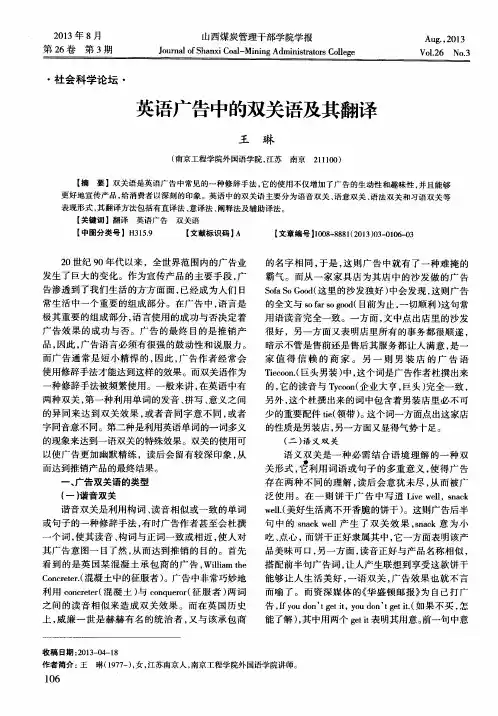
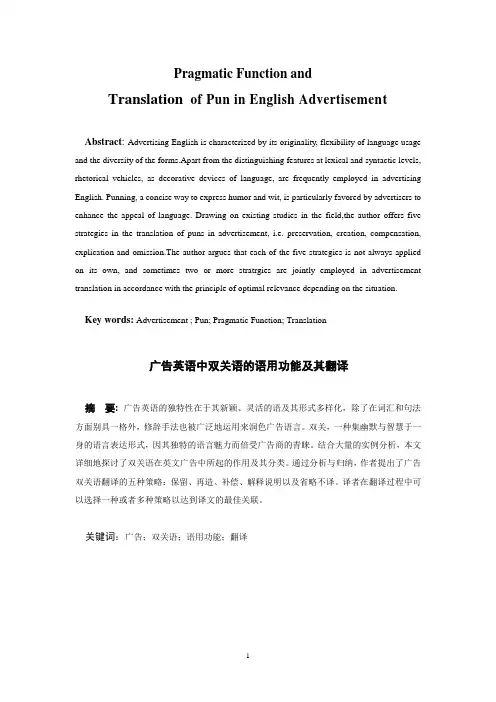
Pragmatic Function andTranslation of Pun in English Advertisemen tAbstract: Advertising English is characterized by its originality, flexibility of language usage and the diversity of the forms.Apart from the distinguishing features at lexical and syntactic levels, rhetorical vehicles, as decorative devices of language, are frequently employed in advertising English. Punning, a concise way to express humor and wit, is particularly favored by advertisers to enhance the appeal of language. Drawing on existing studies in the field,the author offers five strategies in the translation of puns in advertisement, i.e. preservation, creation, compensation, explication and omission.The author argues that each of the five strategies is not always applied on its own, and sometimes two or more stratrgies are jointly employed in advertisement translation in accordance with the principle of optimal relevance depending on the situation.Key words: Advertisement; Pun; Pragmatic Function; Translation广告英语中双关语的语用功能及其翻译摘要: 广告英语的独特性在于其新颖、灵活的语及其形式多样化,除了在词汇和句法方面别具一格外,修辞手法也被广泛地运用来润色广告语言。
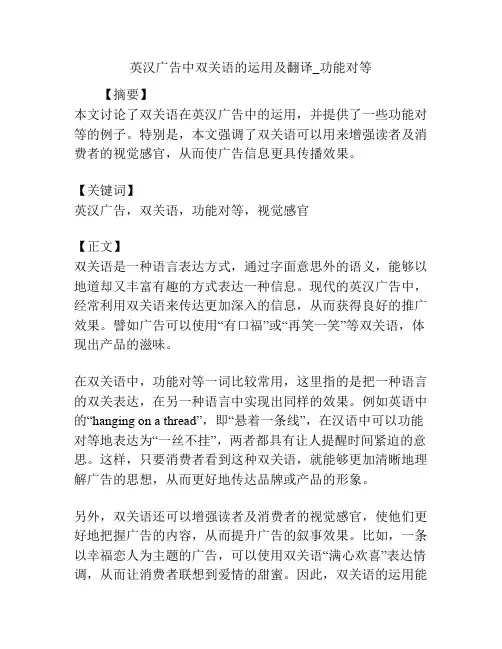
英汉广告中双关语的运用及翻译_功能对等【摘要】本文讨论了双关语在英汉广告中的运用,并提供了一些功能对等的例子。
特别是,本文强调了双关语可以用来增强读者及消费者的视觉感官,从而使广告信息更具传播效果。
【关键词】英汉广告,双关语,功能对等,视觉感官【正文】双关语是一种语言表达方式,通过字面意思外的语义,能够以地道却又丰富有趣的方式表达一种信息。
现代的英汉广告中,经常利用双关语来传达更加深入的信息,从而获得良好的推广效果。
譬如广告可以使用“有口福”或“再笑一笑”等双关语,体现出产品的滋味。
在双关语中,功能对等一词比较常用,这里指的是把一种语言的双关表达,在另一种语言中实现出同样的效果。
例如英语中的“hanging on a thread”,即“悬着一条线”,在汉语中可以功能对等地表达为“一丝不挂”,两者都具有让人提醒时间紧迫的意思。
这样,只要消费者看到这种双关语,就能够更加清晰地理解广告的思想,从而更好地传达品牌或产品的形象。
另外,双关语还可以增强读者及消费者的视觉感官,使他们更好地把握广告的内容,从而提升广告的叙事效果。
比如,一条以幸福恋人为主题的广告,可以使用双关语“满心欢喜”表达情调,从而让消费者联想到爱情的甜蜜。
因此,双关语的运用能够提升广告的表现力,使其与众不同,更能够吸引更多的消费者注意力。
总之,双关语在英汉广告中具有很重要的作用,特别是运用功能对等技巧来提高叙事效果,从而使广告更具传播效果。
翻译:本文讨论了双关语在英汉广告中的使用,并提出了一些功能对等的例子。
特别是,强调双关语能增强读者及消费者的视觉感官,从而让广告信息更具传播效果。
双关语可以使用“有口福”或“再笑一笑”等词语表达产品的滋味,而功能对等的技巧则能够使得英汉双关语在另一种语言中实现同样的效果。
此外,双关语还能增强消费者的视觉感官,从而让广告更具叙事效果。
因此,双关语在英汉广告中具有重要意义,可以使其与众不同,更能够吸引更多的消费者注意力。
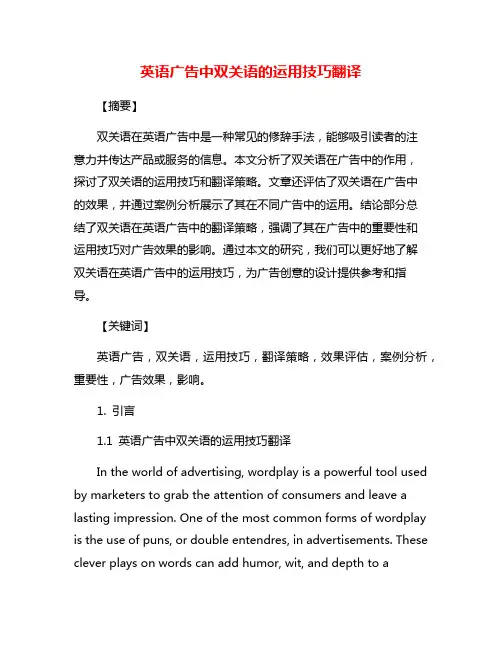
英语广告中双关语的运用技巧翻译【摘要】双关语在英语广告中是一种常见的修辞手法,能够吸引读者的注意力并传达产品或服务的信息。
本文分析了双关语在广告中的作用,探讨了双关语的运用技巧和翻译策略。
文章还评估了双关语在广告中的效果,并通过案例分析展示了其在不同广告中的运用。
结论部分总结了双关语在英语广告中的翻译策略,强调了其在广告中的重要性和运用技巧对广告效果的影响。
通过本文的研究,我们可以更好地了解双关语在英语广告中的运用技巧,为广告创意的设计提供参考和指导。
【关键词】英语广告,双关语,运用技巧,翻译策略,效果评估,案例分析,重要性,广告效果,影响。
1. 引言1.1 英语广告中双关语的运用技巧翻译In the world of advertising, wordplay is a powerful tool used by marketers to grab the attention of consumers and leave a lasting impression. One of the most common forms of wordplay is the use of puns, or double entendres, in advertisements. These clever plays on words can add humor, wit, and depth to amessage, making it more memorable and engaging for the audience.2. 正文2.1 双关语在广告中的作用双关语在广告中的作用是非常重要的。
通过运用双关语,广告可以在短短几句话或一个画面中传递多重意义,吸引消费者的注意力。
双关语不仅可以增加广告的趣味性,还可以创造出独特的印象,让广告更容易被记住。
双关语还可以增加广告的幽默感和情感色彩,让消费者在观看广告时感受到愉快和喜剧。
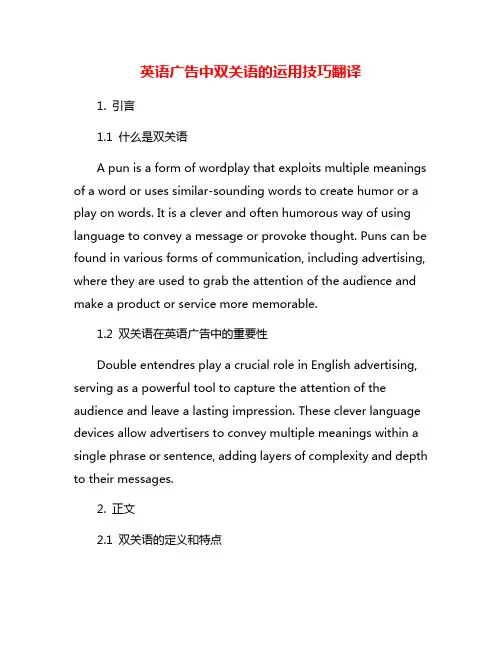
英语广告中双关语的运用技巧翻译1. 引言1.1 什么是双关语A pun is a form of wordplay that exploits multiple meanings of a word or uses similar-sounding words to create humor or a play on words. It is a clever and often humorous way of using language to convey a message or provoke thought. Puns can be found in various forms of communication, including advertising, where they are used to grab the attention of the audience and make a product or service more memorable.1.2 双关语在英语广告中的重要性Double entendres play a crucial role in English advertising, serving as a powerful tool to capture the attention of the audience and leave a lasting impression. These clever language devices allow advertisers to convey multiple meanings within a single phrase or sentence, adding layers of complexity and depth to their messages.2. 正文2.1 双关语的定义和特点Double entendre, a literary device that involves a word or phrase that has two different meanings or interpretations, is commonly used in English advertising to create a sense of wit and humor. This technique allows advertisers to capture the attention of consumers and make their messages more memorable.2.2 英语广告中双关语的优势Another advantage of using puns in English advertising is their ability to create a positive association with the brand. A well-placed pun can convey a sense of creativity and playfulness, which can reflect positively on the brand's image. Puns can also help in creating a unique identity for the brand, setting it apart from competitors and making it more memorable to consumers.2.3 双关语的运用技巧Double entendre is a clever linguistic device often used in English advertising to add humor, create intrigue, and engage the audience. Here are some key techniques for effectively using double entendre in English advertisements:2.4 双关语的翻译挑战Secondly, cultural references and wordplay that are familiar and effective in one culture may not have the same impact inanother. Translators need to be aware of cultural differences and audience expectations to ensure that the humor in the puns is not lost in translation.2.5 如何有效地翻译英语广告中的双关语Effective Translation of Pun in English AdvertisementsTranslating puns in English advertisements can be a challenging task, as it requires careful consideration of both the literal and figurative meanings of the words involved. Here are some tips on how to effectively translate puns in English advertisements:3. 结论3.1 双关语在英语广告中的重要性不容忽视In English advertising, the use of puns is essential and cannot be overlooked. Puns not only grab the attention of the audience but also make the advertisement more memorable and engaging. They add a touch of humor and creativity to the message being conveyed, making it more appealing to the target market.3.2 翻译双关语需谨慎处理,保持原意和幽默感Translating puns requires careful handling to ensure that the original meaning and humor are preserved. It is crucial for translators to fully understand the cultural context and linguistic nuances of both languages in order to effectively convey the double meanings present in puns. Additionally, translators must possess a creative mindset and a good sense of humor to successfully recreate the wit and cleverness that are characteristic of puns.。
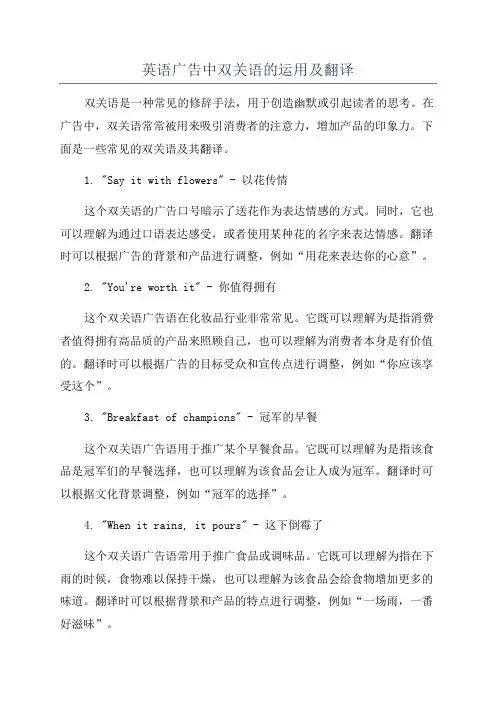
英语广告中双关语的运用及翻译双关语是一种常见的修辞手法,用于创造幽默或引起读者的思考。
在广告中,双关语常常被用来吸引消费者的注意力,增加产品的印象力。
下面是一些常见的双关语及其翻译。
1. "Say it with flowers" - 以花传情这个双关语的广告口号暗示了送花作为表达情感的方式。
同时,它也可以理解为通过口语表达感受,或者使用某种花的名字来表达情感。
翻译时可以根据广告的背景和产品进行调整,例如“用花来表达你的心意”。
2. "You're worth it" - 你值得拥有这个双关语广告语在化妆品行业非常常见。
它既可以理解为是指消费者值得拥有高品质的产品来照顾自己,也可以理解为消费者本身是有价值的。
翻译时可以根据广告的目标受众和宣传点进行调整,例如“你应该享受这个”。
3. "Breakfast of champions" - 冠军的早餐这个双关语广告语用于推广某个早餐食品。
它既可以理解为是指该食品是冠军们的早餐选择,也可以理解为该食品会让人成为冠军。
翻译时可以根据文化背景调整,例如“冠军的选择”。
4. "When it rains, it pours" - 这下倒霉了这个双关语广告语常用于推广食品或调味品。
它既可以理解为指在下雨的时候,食物难以保持干燥,也可以理解为该食品会给食物增加更多的味道。
翻译时可以根据背景和产品的特点进行调整,例如“一场雨,一番好滋味”。
5. "Life's a journey, enjoy the ride" - 人生是一场旅程,享受骑行吧这个双关语广告语常用于推广交通工具或旅游产品。
它既可以理解为是指人生是一段旅程,要享受其中的乐趣,也可以理解为指通过骑行来享受生活的方式。
翻译时可以根据广告的背景和产品进行调整,例如“人生如旅,快乐骑行”。
总体而言,双关语在英语广告中被广泛使用,因为它能够吸引消费者的注意力,增加广告的趣味性和记忆力。
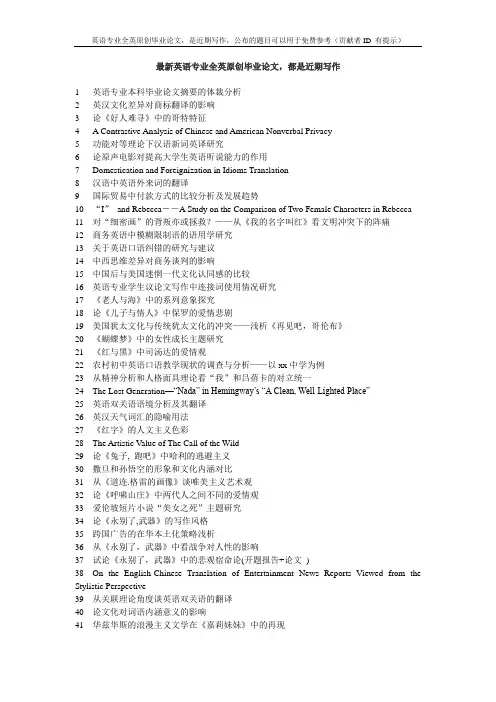
最新英语专业全英原创毕业论文,都是近期写作1 英语专业本科毕业论文摘要的体裁分析2 英汉文化差异对商标翻译的影响3 论《好人难寻》中的哥特特征4 A Contrastive Analysis of Chinese and American Nonverbal Privacy5 功能对等理论下汉语新词英译研究6 论原声电影对提高大学生英语听说能力的作用7 Domestication and Foreignization in Idioms Translation8 汉语中英语外来词的翻译9 国际贸易中付款方式的比较分析及发展趋势10 “I”and Rebecca--A Study on the Comparison of Two Female Characters in Rebecca11 对“细密画”的背叛亦或拯救?——从《我的名字叫红》看文明冲突下的阵痛12 商务英语中模糊限制语的语用学研究13 关于英语口语纠错的研究与建议14 中西思维差异对商务谈判的影响15 中国后与美国迷惘一代文化认同感的比较16 英语专业学生议论文写作中连接词使用情况研究17 《老人与海》中的系列意象探究18 论《儿子与情人》中保罗的爱情悲剧19 美国犹太文化与传统犹太文化的冲突——浅析《再见吧,哥伦布》20 《蝴蝶梦》中的女性成长主题研究21 《红与黑》中司汤达的爱情观22 农村初中英语口语教学现状的调查与分析——以xx中学为例23 从精神分析和人格面具理论看“我”和吕蓓卡的对立统一24 The Lost Generation—“Nada” in Hemingway’s “A Clean, Well-Lighted Place”25 英语双关语语境分析及其翻译26 英汉天气词汇的隐喻用法27 《红字》的人文主义色彩28 The Artistic Value of The Call of the Wild29 论《兔子, 跑吧》中哈利的逃避主义30 撒旦和孙悟空的形象和文化内涵对比31 从《道连.格雷的画像》谈唯美主义艺术观32 论《呼啸山庄》中两代人之间不同的爱情观33 爱伦坡短片小说“美女之死”主题研究34 论《永别了,武器》的写作风格35 跨国广告的在华本土化策略浅析36 从《永别了,武器》中看战争对人性的影响37 试论《永别了,武器》中的悲观宿命论(开题报告+论文)38 On the English-Chinese Translation of Entertainment News Reports Viewed from the Stylistic Perspective39 从关联理论角度谈英语双关语的翻译40 论文化对词语内涵意义的影响41 华兹华斯的浪漫主义文学在《嘉莉妹妹》中的再现42 高中英语写作作业的反馈及实施效果43 文化对在校英语学习的重要性44 弗吉尼亚.伍尔夫《达洛卫夫人》的生态女性主义解读45 从商业广告看文化因素对广告翻译的影响46 美国黑人英语的句法特征47 《瓦尔登湖》生态批评视角分析48 罗伯特.弗罗斯特田园诗歌意象的象征意义49 《谁动了我的奶酪》中的象征意义50 试析诗歌翻译中文化意象的处理51 An Analysis of Self-reliance in Little Women52 乔伊斯的生活经历对其作品的影响--他是怎样刻画人物的53 Everlasting Colonialism-An Interpretation of the Great Gatsby54 On Sentence Division and Combination in C-E Literature Translation55 商标翻译分析56 浅谈商务英语句法特点及翻译技巧57 玛丽.巴顿的女性意识58 英汉社交称呼语礼貌规范和语用失误研究59 埃德加·爱伦·坡幽默小说研究60 《榆树下的欲望》和《雷雨》中悲剧性的差异61 A Comparative Study of Women in Fortress Besieged and Pride and Prejudice62 《汤姆·索亚历险记》中所反映的社会问题63 影响英语专业学生阅读理解因素的分析及对策探讨6465 浅谈英语“根据”表达法66 英语体育新闻中模糊语言的词汇特点及其翻译对策67 目的论视角下《瓦尔登湖》两个中文译本的分析68 论古诗的翻译技巧69 问题类型对TEM阅读成绩影响的实证研究70 汉英亲属称谓词的文化差异及翻译71 从功能对等理论谈中国小吃名英译72 城市公共标识翻译技巧及问题分析73 Application of Cooperative Principles in the Study of Intercultural Business Negotiation7475 论罗伯特.佩恩.沃伦《国王的人马》中对真理与自我认知的追求76 Western and Chinese Marriage Differences in Cross-cultural Communication77 论世纪年代以来美国文化冲击对中国青少年的影响及教育策略改革的应对措施78 中国英语学习者道歉言语行为的中介语石化现象79 英语词汇中的性别歧视80 《弗洛斯河上的磨坊》中麦琪悲剧原因分析81 Cultural Difference between Chinese and English on Politeness82 A Freudian Psychoanalytical Interpretation of Catherine and Heathcliff in Wuthering Heights83 论托妮莫里森《最蓝的眼睛》中的母女关系84 动物词在中英文化中的喻义及其翻译85 On Loss of Fidelity in Translation86 从彼拉特透视托尼·莫里森的妇女主义87 《宠儿》女主人公赛斯人物形象分析88 从英汉动物成语比较中英文化差异89 英汉被动句语义特征对比分析90 Analysis on Requirements for Translation Graduates from the Perspective of Recruit Advertisements91 融入与挑战——从生态角度看《老人与海》与《瓦尔登湖》92 高中英语写作中母语负迁移现象分析93 言语行为理论视角下口语交际误解现象94 论《太阳照常升起》中的象征主义95 The Reli gious Thoughts in The Pilgrim’s Progress96 论《双城记》中的现实主义风格97 对小妇人心灵成长历程的探索98 论中学英语互动教学99 《德伯家的苔丝》中苔丝悲剧的分析100 儒家文化与和谐世界的构建101 回译在翻译教学中的作用102 神经漫游者中的两个世界103 近年来汉语中英语借词的简析104 An Analysis of Bernard Shaw’s Pygmalion from the Perspective of Interpersona l Function 105 浅析国际商务谈判文化因素及其对策106 Cooperative Principle in Business Letters107 从读者接受理论看《达.芬奇密码》的成功108 从奥巴马演讲的不同译文看语域理论在翻译中的应用109 论《呼啸山庄》中的叙述技巧110 论《杀死一只知更鸟》中的象征111 弗吉尼亚.伍尔夫《达洛维夫人》中印象主义创作手法探讨112 文化意识与外语教学113 从《盲人》中的“血性意识”看劳伦斯的文明观114 论中英数字信息差异及其翻译方法115 女性意识的苏醒--对《愤怒的葡萄》中的约德妈妈形象的分析116 工业化进程中的人性异化——解读wrence《儿子与情人》117 论汉语缩略语的英译118 海丝特白兰—清教时代的新女性119 科技英语翻译中的词性转换研究120 目的论视角下的广告翻译121 托马斯.哈代《无名的裘德》中的书信研究122 英汉称谓语的文化差异与翻译--以《京华烟云》为例123 浅析信息时代的汉语新词语英译策略124 从历届美国总统访华演说探讨其对中国所传递的价值观125 On Michael Moore's Fahrenheit / From the Rhetoric Perspective126 概念隐喻在英语汽车广告中的应用127 The Two Mrs.De Winters of Manderly─The comparison between “I”and Rebecca128 论中西教育观的差异129 英文歌词翻译策略探析130 An Analysis of the D Film Alice in Wonderland from the Perspective of Gothicism131 英语广告的修辞及其翻译132 A Preliminary Study on Christianity133 论<<禁食与欢宴>>中乌玛的觉醒134 从合作原则角度简要分析《老友记》中乔伊的性格特征135 《了不起的盖茨比》中黛西的人物性格分析136 On the Causes of the Tragedies of Tess and Jennie in Tess of the d’Urbervilles and Jennie Gerhardt137 《德伯家的苔丝》的圣经原型解读138 中西方饮食文化的比较研究139 顺从还是叛逆——解读《汤姆叔叔的小屋》中的基督教义精神140 英汉委婉语中体现的文化异同141 《十日谈》中的乡村意象142 中西方茶文化对比研究——以红茶为例143 《红字》中作者霍桑对清教认识的模糊性144 论远大前程中皮普的道德观145 中国英语学习者在词汇方面的迁移146 广告英语中语言的性别差异147 从接受美学角度看中英旅游文本的翻译148 异化的美国梦:小说《教父》的主题解读149 论英汉翻译中的文化因素150 《野草在歌唱》中野草的象征寓意解读151 从广交会现场洽谈角度论英语委婉语在国际商务谈判中的功能与应用152 用言语行为理论分析奥巴马推定总统候选人演讲153 文化视野下的中美家庭教育方法的比较154 从合作原则分析《生活大爆炸》中字幕幽默的翻译155 浅析英语习语的翻译原则和方法156 电影《死亡诗社》中的教育意义157 中学英语阅读教学存在的问题及解决方案158 《白鲸》的象征意义和悲剧内涵分析159 中西广告语言中的文化差异160 Advertisement translation from the Perspective of Nida’s Functional Equivalence Theory 161 从目的论看《长腿叔叔》的中译162 汉英动物词文化内涵的对比163 论麦琪的悲剧164 文学翻译中的译者主体性165 论概念隐喻视角下的隐喻翻译166 跨文化交际视角下的英汉动物词语研究167 The Influence of Bob Dylan and His Works on American Social Movements168 美国寻梦—凯鲁亚克小说《在路上》的主题研究169 商务信函中委婉语的使用策略170 《名利场》中蓓基人物形象分析171 浅谈跨文化视角下的英汉习语互译172 初中英语词汇教学法研究综述173 An Analysis of the Symbolic Meanings of the Letter “A” in The Scarlet Letter 174 浅析英语专业学生在听力理解中的策略运用175 The Otherization of China in The Woman Warrior176 论词典在高中英语词汇学习中的有效利用177 论《紫色》中的姐妹情谊178 汉语公示语英译之跨文化交际研究179 女权主义翻译理论关照下的《呼啸山庄》多个译本比较研究180 爱米丽的悲剧成因—评福克纳的小说《献给爱米丽的一朵玫瑰花》181 英汉数字习语的翻译182 探究中学生厌倦学习英语183 英语电影片名的汉译研究184 从语言角度分析面子理论在英语商务谈判中的作用185 《老人与海》中的存在主义分析186 女性主义视角下《大地》的解读187 浅析电影《我是山姆》中的反智主义188 跨文化视角视阈下英语电影片名的翻译研究189 公示语翻译失当分析——以电影票等的顾客分析为例( )190 从文化角度看林语堂的《吾国与吾民》191 试析广告英语中语言的性别差异——从功能分析的角度着手192 A Cross-Cultural Study on Linguistic Taboo193 论商标名称的翻译对品牌形象的影响194 论凯瑟琳.曼斯菲尔德作品中的彼得.潘情结195 A Brief Study of Chinglish in C-E Translation196 从苔丝的悲剧到托马斯.哈代的宿命论197 盖茨比的人物形象分析198 商务英语和普通英语对比浅析199 The Racial Stereotypes in American TV Media200 论英语广告语中的双关应用及翻译。
校园英语 / 翻译探究英语广告中双关语的运用技巧及翻译三亚学院外国语学院/曾庆瑜【摘要】双关是一种比较常用到的修辞手法,其作用是使语言的表达简洁明了,言简意赅。
广告语的突出特点就是要用最简短的语言表达最丰富的含义,同时又能够给消费大众留下深刻的印象,所以其最常使用双关的手法。
英语广告语中双关语的应用形式主要有:谐音双关、语义双关以及语法双关,三种双关使用的目的都是为了增强语言的表达效果,起到“言有尽、意无穷”的效果,而由于语言表达思维以及文化的差异性,应用双关语的广告语的翻译要比一般的英语句子难翻译。
【关键词】双关 英语广告语 应用形式 翻译一、引言双关语主要指的是在特定的语言环境中,围绕特定的目的,运用语音、词汇、语法等形式表达出两层或者是多层不同的意思,广告由于要求语言简练但是表达意思要耐人寻味,所以最常使用双关语。
英语广告语双关语的翻译对于很多翻译者而言都是一个重要的难题。
英语广告双关语使用的目的在于能够对消费大众产生巨大的吸引力,以激发消费者的消费欲望,然而由于中英文语言结构以及文化的差异性,很多英语广告的翻译都失去了双关的意味,无法翻译出一语双关的效果。
二、双关在英语广告中的应用双关是一种重要的修辞手法,其作用在于使得表达的语言形式符合经济性原则,同时也使得语言幽默有韵律,带给消费大众不一样的听觉感受,使大众容易记住广告词,广告语的特征与功能决定了双关语在广告中的大量使用。
总的来说双关在应用广告中的运用方式主要有以下几种:1.谐音双关。
谐音双关主要利用音近或者是音同的条件所组成的双关语,使消费大众听起来意味深长,给人留下深刻印象,以实现宣传产品的目的。
例如:Trust us,over 5000 ears of experience (相信我们吧,历经5000多只耳朵的检验,有着5000多年的经验)。
在这句关于助听器的广告语中,“ear”与“year”的音很近,而experience 很容易让消费大众大众联想到时间的长久,“ear字面意思是指该产品已经被广大的消费者所验证,同时听起来还有历经5000年“experience”的味道,所以使得广告语拥有了双重的语境,让人感觉这款助听器历史悠久,质量值得信赖。
英语广告中双关语的运用及翻译
一、双关语是什么
双关语(Double entendre)是指在一个句子中,意思同时可以读出
两种意思,其中一种意思常常带有有趣的影射和幽默的意味。
双关语的最
大特点就是在一句话中包含两种意思,其中有一种意思是直接表达的,而
另一种意思是潜台词,它们之间并不存在联系,但是从字面上理解后,就
可以发现双关语的存在。
二、双关语在英语广告中的运用
1、具有幽默性
双关语在英语宣传广告中常常带有一定的幽默性,它可以激发观众的
共鸣,同时也可以让观众记住品牌,而且让观众的情绪也跟着提升。
比如,可口可乐宣传口号“Open happiness”,直译:“打开快乐”,双关语的
寓意就在于:通过喝可乐来获得幸福快乐。
2、引起兴趣
双关语以其新颖别致,抑扬顿挫的编排,含蓄深刻,具有极强的触发
性和诱因,可谓无人不识。
双关语的运用,能很好地吸引观众的眼球,让
他们对这款产品有兴趣,因此很多大型品牌在宣传时也常常会用到双关语
的技巧来激发大家的共鸣,比如说,微软的宣传语“Where do y ou want
to go today?”,直译:“今天你想去哪里?”这里强调不仅仅是今天,
而是用几个词来激发你的兴趣,以及可以到达的地方可以有多特别,即使
有极大的空间来探索,可以让观众有更多的想象空间。
试论英语广告中双关语的翻译广告,就是广而告之, 其目的是要在瞬间吸引人们的注意, 给他们留下深刻的印象, 激起人们的购买欲望。
双关是利用某些词语或句子的语音或语义条件, 使其在特定的语境中带有明暗双重意义。
英语中一般有两种双关, 一种是谐音双关,即利用拼写相似, 发音相同或相近的词构成的双关; 一种是语义双关,即利用英语一词多义的特点, 使词语或句子的多义性在特定环境下形成的双关。
双关的使用可以使读者感到在幽默中见智慧, 在平淡中见新奇. 由于双关语具有简洁凝练。
风趣幽默.新颖别致.耐人寻味等修辞效果, 能够突出广告的特点,所以在广告中得以大量应用。
1.英语广告中双关语的翻译关于翻译标准, 中外翻译理论家提出了不同的主张。
从严复的“信、达、雅”, 傅雷的“重神似不重形似”, 到鲁迅的“忠实通顺”; 从黜秋白的“等同概念”到美国著名翻译理论家Nida的“功能对等”或“动态对等”, 我们可以看出, 这些主张都是指译文要忠实准确地表达原文的意义, 保持原文的风格。
而所谓忠实表达原文的意义, 指的是忠实表达原文的字面意义.隐含意义等。
作为信息传播的手段, 广告用语具有简洁、生动、形象、富于感染力的特点。
广告语言是一种精练、含蓄、富有表现力和鼓动性的语言, 而双关又是双重意义的表达, 这就给英语广告中双关的翻译造成语言结构和表达上的困难。
因此, 英语广告中双关的翻译应根据广告的内容和特点, 既要充分照顾到原文的语体风格, 又要尽量传达出原文的信息。
在翻译方法上, 直译与意译一直是翻译界争论的焦点。
直译与意译是相对的, 两者之间相互联系, 且没有绝对的界限.一篇好的译作总是既有直译, 又有意译的, 直译与意译相结合。
如果采用直译能准确传达原文多种意义的, 就直译; 如果不能翻译出原文的多种意义, 特别是不能传达出隐含意义的, 就采取意译的方法。
所以, 对英语广告中双关的翻译, 应采用辨证的办法, 一方面要考虑到广告的语体特征, 另一方面要尽可能减少双关在翻译中信息的流失。
Pragmatic Function and Translation of Pun in EnglishAdvertisementAbstract: Advertising English is characterized by its originality, flexibility of language usage and the diversity of the forms.Apart from the distinguishing features at lexical and syntactic levels, rhetorical vehicles, as decorative devices of language, are frequently employed in advertising English. Punning, a concise way to express humor and wit, is particularly favored by advertisers to enhance the appeal of language. Drawing on existing studies in the field,the author offers five strategies in the translation of puns in advertisement, i.e. preservation, creation, compensation, explication and omission.The author argues that each of the five strategies is not always applied on its own, and sometimes two or more stratrgies are jointly employed in advertisement translation in accordance with the principle of optimal relevance depending on the situation.Key words: Advertisement; Pun; Pragmatic Function; Translation广告英语中双关语的语用功能及其翻译摘要: 广告英语的独特性在于其新颖、灵活的语及其形式多样化,除了在词汇和句法方面别具一格外,修辞手法也被广泛地运用来润色广告语言。
双关,一种集幽默与智慧于一身的语言表达形式,因其独特的语言魅力而倍受广告商的青睐。
结合大量的实例分析,本文详细地探讨了双关语在英文广告中所起的作用及其分类。
通过分析与归纳,作者提出了广告双关语翻译的五种策略:保留、再造、补偿、解释说明以及省略不译。
译者在翻译过程中可以选择一种或者多种策略以达到译文的最佳关联。
关键词:广告;双关语;语用功能;翻译IntroductionThe definition of advertisement by AMA(American Marketing Association): Advertising is the nonpersonal communication usually paid for and usually persuasive in nature about products, services of ideas by identified sponsors through the various media. It is a device to arouse consumers‘ attention to a commodity and induce them to use it. In modern age, people find themselves surrounded by various advertisements each day. An American writer writes: ― we find advertisement of all kinds ever ywhere, for example, glittering neon signs on top of high buildings and a long main streets, colorful pictures painted on buses pamphlets sent to very house, advertisement jammed between TV programs various advertisement glutting, newspaper and radio broad cast; etc.‖Facing so many advertisement, how to make the advertisement impressive is the main purpose of the advertisers. In order to enhance the appeal of an advertisement, advertisers pay much attention not only to such expressive devices as plates, color and the layout of a printed page, but also to the choice of words or phrases, to make an advertisement beautiful and attractive.In the practice of the advertising English, people pay more attention to pun to make the advertisement succinct, accurate and vivid and to provide rich imagination and plentiful associations for readers so as to stimulate their desire.The frequent and wide use of figures of speech is an important characteristic of advertising English, which is an effective way to make the advertisement attractive. Among the figures, pun is loved deeply. Oxford Advanced Dictionary defines pun as ―humorous use of a word that has two meanings or of different words that sound the same‖ [1]. A pun (also known as paronomasia) can be understood like that it is a deliberate confusion of similar-sounding words of phrases for rhetorical effect, whether humorous or serious. It leaves a deep impression on readers by its readability, wit and humor. It can satisfy the requirement of advertisement characteristics—selling power, memory value, attention value, and readability. So pun is very popular in advertisement. The article just wants to present the pragmatic function and translatability of pun inadvertisement.海量英语论文尽在英语论文网,免费下载网址:/需要其他类型英语论文可以咨询QQ 2537717351 Definition and classification of pun in advertisement1. 1 Definition of punLooking at the same issue from different perspectives, we may often come up with different definitions of the thing under discussion. And, not surprisingly, pun can be thus defined in many ways. There is such a humorous explanation about pun: ―punning –to torture one poor word ten thousand ways (John Dryden)‖. In Longman Dictionary of Contemporary English, pun is defined as ―An amusing use of a word or phrase that has two meanings, or words with the same sound but different meanings‖. According to The Oxford English Dictionary, pun is defined as ―the use of word in such a way as to suggest two or more meanings or different associations, or the use of two or more words of the same or nearly the same sound with different meanings, so as to produce a humorous effect‖. In Princeton Encyclopedia of Poetry and Poetics, pun is defined as ―A figure of speech depending upon a similarity of sound and a disparity of meaning‖. From the above definitions, we can see that homonyms, homophones, and homographs all are available to construct puns with.1. 2 Types of pun in advertisement1. 2. 1Pun on Polysemy―While different words may have the same of similar meaning, the same one word may have more than one meaning. This is what we call polysemy, and such a word is called polysemic word. Historically speaking, polysemy can be understood as the growth and development of or change in the meaning of words.‖ Pun on polysemy is used widely, especially with the name of the product such as the following examples:―From sharp minds. Come sharp products.‖The example is an adverti sement for the Sharp copier. The word ―sharp‖ praises the consumers‘ brightness, but also refers to the Sharp product. The advertisement praises the consumers who are sharp to buy the product which is sharp. The vanity of the audiences is aroused and they want to use it to show their wise, and also they believe the product is really sharp.―Money doesn‘t grow on the trees. But it blossoms at our branches. Lioyd Bank.‖It is the slogan of Lioyd Bank. ―branch‖ means ―part of a tree growing out from the tru nk‖, but here it implies the division of bank‖. The slogan encourages people to store their money in Lioyd Bank, and their money will be like the blooming flowers, yielding better fruits. After understanding its meaning, readers will figure it out in mind that their money will become more and more daily and daily, just like the leaves in spring.1. 2. 2 Pun on Homonym―Homonymy refers to the phenomenon that words with different meanings have the same form, i.e, different words are identical in sound or spelling, or in both. When two words are identical in sound, they are homophones. When the words are identical in spelling, they are homographs. When two words are identical in both spelling and sound, they are com plete homonyms.‖ The follow instances will explain that:― ‗VIPs‘ an atomical comfort.Variable Impact Pressure Sole‖The advertisement of sportshoes uses the homophonic word ―VIPs‖. As we know, VIP usually stands for ― very important persons‖, while, here, it stands for ―Variable Impact Pressure Sole‖. It implies if you use VIPs, you will be a VIP. The word ―VIPs‘ motivates the audiences‘ vanity and induces them to buy the product.―Trust us. Over 5000 ears of experience.‖It is an advertisement for audiphone. The literal meaning is that the product has experienced a lot of texts. While ―ears‖ and ―years‖ are a pair of homophone. So it implies that the product has a long history and has high quality.―Goodbuy Winter! 100% cotton knitwe ar $40‖It is an advertisement for the sale of winter clothes. The advertisement seems to people that it s a good and cheap to buy cotton knitwear. But when the audiences read ―goodbuy winter‖ together, they will understand the good use of pun. ―Goodbuy winter‖ sounds the same as ―goodbye winter‖. The advertisement use homophone to show two meanings: it is a good business to buy the cotton knitwear now, and winter has passed away. Naturally, people will associate the situation happening every year that when they say goodbye to winter, the clothes will have a great discount and it is good time to buy them.―More sun and air for your sun and heir.‖The advertisement is for a bathing beach. The advertiser uses homophone skilfully, sun vs. son, and air vs. heir. The advertiser encourages people to bring their son and heir to the bathing beach to get sun and air to keep fit. Each couple hopes their son and heir will be healthy all their life. Pun makes the advertising language sound sweet, fluent and persuasive.1. 2. 3 Pun on Parody―Parody is a piece of speech, writing of music that imitates the style of an author, composer, etc in an amusing and often exaggerate way‖[2]. Pun on parody uses the outfit of saying, apothegm, proverb or idiom to form new meanings. English has a lot of well-known phrases, idioms and sayings. They are important part of everyday language spoken by the English speakers, and have become one of the aspects of the English culture. The advertisement designers are sharp-minded and imaginative. They change a part of the expressions and put their ideas into them to achieve sensational effect. And most of them achieve a remarkable success. The transformations are not only eye catching, but also easy to be accepted by the common, who will do according to the tradition. As the sayings of idioms have been one part of the tradition, the people will be easily persuaded by the advertisement works of this kind. So pun on parody is popular in advertisement.―A Mars a day helps you work, rest and play.‖It is the slogan of Mars chocolate company. Looking at this advertisement, people will associate it with two idioms: ―An apple a day keeps the doctor away‖ and ― All work and no play makes Jack a dull boy‖. From the meani ngs of the two idioms, the watchword tells people that a Mars‘ chocolate a day will make you not be a dull boy (make you wise) and keep the doctor away (keep fit).―Try our sweet corn, you‘ll smile from ear to ear.‖It is taken from the advertisement fo r a kind of sweet corn. The word ―ear‖ has double meanings: the organ of hearing and the seed –bearing part of a cereal. The idiom ― from ear to ear‖ also is a pun. One meaning is that people are satisfied with the product. The other one is that the consumers eat one ear by another. So the advertisement implies that the sweet corn is very delicious, and you will enjoy it and eating one by one. How can people refuse such delicious food?―All is well that ends well.‖This is an idiom, but here, it is taken from an advertisement of a cigarette. ―End‖, as a verb, means ―finish‖, while, as a noun, means ―cigarette butt‖. The sentence means that if the cigarette ends are good that the cigarette is good.1. 2. 4Pun on GrammarMany advertisers use pun produced for grammar problem to attract the audiences, such as ellipsis or word with different grammar functions. If this type of pun can be used properly, it will achieve unexpected effect.―Which lager can claim to be truly German?This can.‖It is an adverti sement for Lager beer. ―Can‖ is a modal verb. But in the advertisement, a can of beer beside it reminds people ―can‖ has another meaning—tin. Also ―Lager‖ refers to the name of beer. With the illustration, the whole advertisement brings a humorous effect and impresses the audiences deeply. The Coca-cola company also uses ―can‖ to do their advertisement.―Coke refreshes you like no other can.‖Just like last example, ― can ‖ has double meanings, so the sentence can be understand like that Coke refreshes you like no other (can; tin, drink) can (refresh you). It implies their product is the best one. Of course, people like to buy the best one.1. 2. 5 Pun on Illustration and WordsA lot of advertisement associates with illustrations and words to achieve better effect, especially on TV, because people are more easily attracted by pictures than words. The illustrations and words can help people to understand the advertisement fully. Pun in the advertisement must be connected with illustrations and words, so people can understand the implied meanings. For instances:―50% OFF.‖It is a shopwindow advertisement of E-spirit exclusive shop in Shanghai from 2001 and spring festival. The illustration is a picture with six lights, three on and three off. From the illustration, people know it does not only mean a half of the lights are off, but also means the whole sale discounts 50%. The illustration and words are vivid, and attract the passers-by‘ attention more easily.―Stop at two.‖It is the title of an public service advertising (PSA) which the Population andCommunity Development Association ( PCDA) of Thailand uses to advocate the couple to have children no more than two. The illustration is the photo of Wistern Churchill who formed a ―V‖ letter with h is forefinger and middle finger. The gesture ―V‖ means victory. So people also can understand that it is a victory to have only one child. This picture is famous, so people will remember it easily. To achieve thesuccess of their country, people may more like to control the population.海量英语论文尽在英语论文网,免费下载网址:/需要其他类型英语论文可以咨询QQ 2537717352 The pragmatic function of pun in advertisementPun has a lot of advantages such as conciseness, wit and humor, novelty and vividness. It produces a particularly rhetorical and pragmatic effect when people use the language creatively in a specified context. The proper use can make the advertisement impressive and attractive.2. 1 Wit and humorPun, the game of word, produces wit and humor effect to attract the audiences‘ attention and inspires their association. In the age of rapid rhythm, advertisement with pun like a spice makes people enjoy themselves in the advertising atmosphere, and reduces their pressure in a relaxed environment.―When the wind has a bite… and you feel like a bite… then bite on a whole Nut.‖ The word ―bite‖ has several meanings: grip, food, and eat. The whole sentence means that when the strong wind hurts you and you are very hungry, just eat some Nut. After day working, people would feel tired and hungry, while the advertisement is just the situation of them. Therefore, they would be attracted to buy the product, so they will not suffer hunger after work. Also, the sentence sounds like tongue twist.―Excellent Taste!‖It is a word in an advertisement for a whiskey product—Jamson. In the advertisement, when the hero drank the Jamson whiskey that the heroine introduced to him, he said, ―Excellent Taste‖. Generally speaking, ―taste‖ means ―favor‖, but here, another meaning is ―the ability to appreciate what is beautiful‖. So the advertisement means:this kind f whiskey as good flavor; the heroine has high appreciation. The advertiser uses pun to praise both the product and the consumers who choose their product. It caters for people‘ vanity and induces them to buy the product.2. 2 Creativeness and originalityThis is typical of advertising language. An advertisement has a high demand of diction every word playing an important role. If human emotions have to be inspired, the words, strong in expressing emotions, will be chosen. In advertisement, originality is king. A new way of sending message can set a brand apart from copycats and also-rans. So it is important to use something novelsuch as coinage in the advertisement to draw people‘ attention. Normally, a new created word accepted by readers can enhance the freshness and attraction of the advertisement. Good advertisers use coinage to refresh the advertisement and to achieve its propagandist purpose.―Cab Fourward.‖It is an advertisement title of Ram Car produced by Doqi company. The word ―fourward‖ sounds like ―forward‖. Connecting it with the picture in the advertisement, people would know why it uses ‗fourward‖. Because the four d oors of this kind of car could be opened from four directions. The advertiser creates the word ―fourward‖ from ―forward‖ to show the speciality of the car.―Catch the Raincheetah and cheat the rain.‖It is an advertisement in Toronto Daily Star. The pu nny word ―Raincheetah‖, the name of the raincoat, sounds like ―raincheater‖ while the word ―raincheater‖ derives from ―windcheater‖. The word ―cheat‖ in the sentence makes it wonderful and let people feel that this kind of raincoat can protect the consumers well. Pun gives people impression of novelty and interest.2. 3 Satisfying people’s requirement of beautyA good advertisement is a text from which people can appreciate the art of language, especially advertisement using pun. Pun in advertisement is orderly and antithetic that makes people feel the aesthetic modality of language. The characters of pun, such as vividness, wit and humor, pleasure people‘s spirit and let them enjoy the beauty of language. For instance:―Give your hair a touch of spring.‖It is an advertisement for shampoo. The word ―spring‖ here is very vivid and like a picture in people‘ mind: after using the shampoo, the long hair becomes elastic and shining. When you stand there, your hair will go with wind. Everyone likes beauty, so the advertisement caters for people‘ desire and induces them to buy the product to make them more beautiful.2. 4 Satisfying the requirement of society—EconomyWith the rapid development of the society, people become busier and busier, so they require short and easy remembered advertisement to supply the message they want. But how to impress the audiences is a question. The answer is using pun. But why is pun especially favored by the advertiser? The main reasons as following:―Firstly, advertisement is paid message, with limited space and time, so it doesn‘t allow verbiage to waste the investment. Pun with double meaning has the characteristic of small carrier but plenty of connotations. So it is very economic, effective and money-saving to the advertiser. Secondly, in modern society, people pay more and more attention to effect, and get tired of the tedious advertisement. The pun in advertisement is usually formed by short sentences. Some use the name of the product as the theme of the advertisement. Some use excellent phrases to show the specialties of the product. To the audiences, it saves their time to get the information they want. Thirdly, usually, the audiences read or watch advertisement unintentionally and only can remember something unconsciously. So, to achieve expected propagandist effect, the advertisement must reduce the memory message. Pun is suitable for the requirement. The content is short, the form rhythmic, and the style novel, which are easily remembered and impressed people deeply‖ [3]. In a word, pun uses fewer words to express full message which is the content of Economy Principle, and it usually reaches the purpose of advertisement that is arouse consumers‘ attention to a commodity and induce them to use it. For instance:―Two beer or not two beer, that‘s a question.----Shakesbeer‖Looking at the beer advertisement, people would associate it with the proverb ―To be or knot to be, that‘s a question‖ in Hamlet. Shakesbeer is the name of the beer, but it sounds like ―Shakespeare‖ who is known nearly all over the world, so it is easy forpeople to remember the Shakesbeer. And the word said by Hamlet is also very famous, especially in western country. The sentence is short and the pattern is famous, so people will remember the product naturally.―Go well, Go Shell.‖It is an advertisement for Shell Oil Company. ―Well‖ sounds like ―where‖, so it implies that go to Shell company to buy oil. Only four words are used in the advertisement, but express the meaning fully and impress people deeply. Imagine that one day, when you drive your car, suddenly, the oil is run out. So you are wondering where to go, then, of course, you will remember the words ―Go well, go Shell‖. So you will go to Shell at once. The slogans impress the audiences deeply and persuade them to buy the product invisibly.―Make Time For Time.‖It is an advertisement for Time magazine. The advertisement uses the pun on homonymy of the word ―time‖ to refer two meanings: c ommon sense of time, and the name of he magazine. The advertisement means that read Time magazine to seize time. In the society full of competition, time is important and magazines also play an important role which people have to read to broaden their view. While Time magazine will not only broaden view, but also save your time. It satisfies people‘s requirement.2. 5 Implying WarningSome advertisements imply warming. Pun can make the warming vivid and effective so that people can pay attention to it. For instances:―Better late than the late.‖It is a public service advertising of traffic. It derives from the proverb ―Better late than never‖. In the sentence, ―the late‖ means‖ the dead‖, and it reminds the drivers to drive slowly and carefully. The advertisement with pun here has more powerful to persuade the drivers to care their security.Another example:―The driver is safer when the road is dry;The road is safer when the driver is dry.‖ It is also an advertisement for safe driving. The excellent word is ―dry‖ which has double meanings: without water and without drinking. It expresses if the road is dry and the driver doesn‘t drink, all drivers will be safer. The antitheses and thyme of the sentence has more powerful to warm people.2. 6 Marking product more profitable and competiveThe speciality of pun is useful in advertisement, and favored by people. If a advertiser can make full use of it to satisfy people‘s requirement, the product may precede others and gain the market.―A deal with us means a good deal to you.‖Here, the double meanings of ―deal‖ are: the amount and business. The meanings of the advertisement are that: do trade with us is a good business to you; doing business with us, you will get a lot. Advertisers use pun skilful to in spire the audiences‘ curiosity and attract their interest to do the deal.―Powe to influence others.‖It is an advertisement for a Hector Powe Clothing Company. They advocate that if you wear their clothes, you will have power to influence other people. Because ―Powe‖ is like ―power‖. It satisfies people‘s desire of power, so they like to have a try. Thus, it will bring great profit to the Powe company. Maybe people with the clothes can‘t have more power, but the company has the power to influence the ma rket.3 Five strategies of translation of puns in English advertisementOn the basis of previous studies on translation of puns, the author tentatively proposes five potential strategies for translation of puns in English advertisements, some of which have already been touched upon in the previous section. They include preservation, creation, compensation, explication and omission[4]. These five strategies, adopted in accordance with the principle of optimal relevance, have some advantages. First, they have already been widely employed in practice and are generalized from the previous studies, thus they have solid foundation. Secondly, they can cover most of the important methods proposed by other scholars as we can see in the analysis in the previous sections. Thirdly, these five strategies stem from a comprehensive perspective: such aspects as form, meaning and function have been taken into account. So we hope these strategies will prove to be effective in real work. It should be pointed out that each of the five strategies is not always applied on its own; sometimes two or more strategies are jointly employed in an advertisement depending on the situation. When there is more than one pun in an advertisement,different strategies can be applied to different pun depending on the situation. For instance, some can be preserved, some explicated, and some omitted. However, whatever the situation is, whatever strategies the translator should choose, depends on whether optimal relevance can be achieved, i.e. the choice has to be made in accordance with the principle of optimal relevance. In the following sections, these five strategies will be explained.3. 1 PreservationFor those advertisements that mainly appeal to emotions, e.g. texts abundant with rhetorical devices such as pun, the persuasive power lies in the successful conveyance of the rich meaning in these rhetorical devices. Preservation is one of the effective ways to represent the strength of the original, and it is also one of the often-employed approaches available to the translator, but it should be adopted on the condition that there is a large degree of overlap in both the source language and the target language in terms of linguistic features and the cognitive environment of the source language and the target language reader on the subject to be translated, so that by doing so it neither causes clash in the target language culture nor misleads the reader when he/she processes it and therefore the original and the translated closely resemble each other, and if possible have the same effects on the reader. Such linguistic features may be morphologic, phonetic, syntactic and semantic, etc., which still preserve(as much as possible)the communicative clues of the original,or resemblance in linguistic properties. Eg. An Apple for everybody keeps worries away.Version A: 电脑选苹果,烦恼远离我。